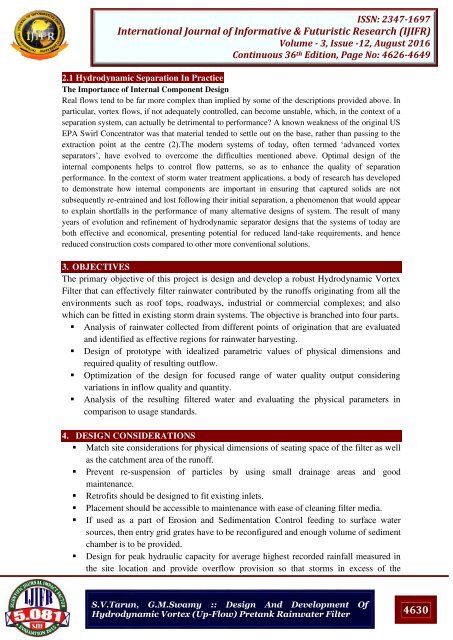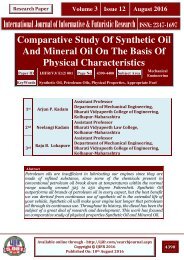IJIFR VOLUME 3 ISSUE 12 AUGUST 2016
RESEARCH PAPER
RESEARCH PAPER
Create successful ePaper yourself
Turn your PDF publications into a flip-book with our unique Google optimized e-Paper software.
ISSN: 2347-1697<br />
International Journal of Informative & Futuristic Research (<strong>IJIFR</strong>)<br />
Volume - 3, Issue -<strong>12</strong>, August <strong>2016</strong><br />
Continuous 36 th Edition, Page No: 4626-4649<br />
2.1 Hydrodynamic Separation In Practice<br />
The Importance of Internal Component Design<br />
Real flows tend to be far more complex than implied by some of the descriptions provided above. In<br />
particular, vortex flows, if not adequately controlled, can become unstable, which, in the context of a<br />
separation system, can actually be detrimental to performance? A known weakness of the original US<br />
EPA Swirl Concentrator was that material tended to settle out on the base, rather than passing to the<br />
extraction point at the centre (2).The modern systems of today, often termed ‘advanced vortex<br />
separators’, have evolved to overcome the difficulties mentioned above. Optimal design of the<br />
internal components helps to control flow patterns, so as to enhance the quality of separation<br />
performance. In the context of storm water treatment applications, a body of research has developed<br />
to demonstrate how internal components are important in ensuring that captured solids are not<br />
subsequently re-entrained and lost following their initial separation, a phenomenon that would appear<br />
to explain shortfalls in the performance of many alternative designs of system. The result of many<br />
years of evolution and refinement of hydrodynamic separator designs that the systems of today are<br />
both effective and economical, presenting potential for reduced land-take requirements, and hence<br />
reduced construction costs compared to other more conventional solutions.<br />
3. OBJECTIVES<br />
The primary objective of this project is design and develop a robust Hydrodynamic Vortex<br />
Filter that can effectively filter rainwater contributed by the runoffs originating from all the<br />
environments such as roof tops, roadways, industrial or commercial complexes; and also<br />
which can be fitted in existing storm drain systems. The objective is branched into four parts.<br />
• Analysis of rainwater collected from different points of origination that are evaluated<br />
and identified as effective regions for rainwater harvesting.<br />
• Design of prototype with idealized parametric values of physical dimensions and<br />
required quality of resulting outflow.<br />
• Optimization of the design for focused range of water quality output considering<br />
variations in inflow quality and quantity.<br />
• Analysis of the resulting filtered water and evaluating the physical parameters in<br />
comparison to usage standards.<br />
4. DESIGN CONSIDERATIONS<br />
• Match site considerations for physical dimensions of seating space of the filter as well<br />
as the catchment area of the runoff.<br />
• Prevent re-suspension of particles by using small drainage areas and good<br />
maintenance.<br />
• Retrofits should be designed to fit existing inlets.<br />
• Placement should be accessible to maintenance with ease of cleaning filter media.<br />
• If used as a part of Erosion and Sedimentation Control feeding to surface water<br />
sources, then entry grid grates have to be reconfigured and enough volume of sediment<br />
chamber is to be provided.<br />
• Design for peak hydraulic capacity for average highest recorded rainfall measured in<br />
the site location and provide overflow provision so that storms in excess of the<br />
S.V.Tarun, G.M.Swamy :: Design And Development Of<br />
Hydrodynamic Vortex (Up-Flow) Pretank Rainwater Filter<br />
4630



